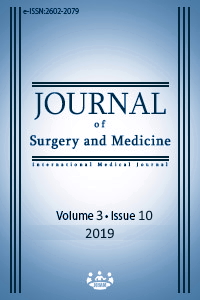Neuroacanthocytosis in a case presenting to emergency department with acute respiratory failure and loss of consciousness: A case report
Keywords:
Acute respiratory failure, Axonal neuropathy, Chorea akanthozytose, Intensive care unit, NeuroacanthocytosisAbstract
The diagnosis of neuroacanthocytosis (NA) is made by the presence of acanthocytes via peripheral smear and by the accompanying clinical picture. Laboratory tests for diagnosis include blood smears to detect acanthocytosis, creatine kinase, genetic analysis and / or chorein level examination with western blot technique. This paper describes the case of a 34 year-old male patient who presented to the emergency department with acute respiratory failure and loss of consciousness. He was intubated and received mechanical ventilatory support after admission to the intensive care unit, and was diagnosed with Chorea akanthozytose (ChAc). We aim to emphasize the need to consider NA among the differential diagnoses for patients presenting with complex clinic such as acute respiratory failure and altered consciousness.
Downloads
References
Stevenson VL, Hardie RJ. Acanthocytosis and neurological disorders. J Neurol. 2001;248:87-94.
Kayahan B, Özdemir F, Bora E. Nöroakantositozis. Turkiye Klinikleri J Med Sci. 2005;25:576-80.
Rafalowska J, Drac H, Jamrozik Z. Neuroacanthocytosis. Review of literature and case report. Folia Neuropathol. 1996;34(4):178-83.
Lossos A, Dobson-Stone C, Monaco AP, Soffer D, Rahamim E, Newman JP, et al. Early clinical heterogeneity in choreoacanthocytosis. Arch Neurol. 2005;62(4):611-4.
Jung HH, Danek A, Walker RH. Neuroacanthocytosis Syndromes. Orphanet Journal of Rare Diseases. 2011;6:68.
Rubio JP, Danek A, Stone C, Chalmers R, Wood N, Verellen C, et al. Chorea acanthocytosis: genetic linkage to chromosome 9q21. Am J Hum Genet. 1997;61:899-908.
Walker RH, Morgello S, Davidoff-Feldman B, Melnick A, Walsh MJ, Shashidharan P, et al. Autosomal dominant chorea-acanthocytosis with polyglutamine-containing neuronal inclusions. Neurology. 2002 Apr 9;58(7):1031-7.
Walker RH, Danek A, Dobson-Stone C. Developments in neuroacanthocytosis: Expanding the spectrum of choreatic syndromes. Mov Disord. 2006;21:1794-805.
Sorrentino G, De Renzo A, Miniello S, Nori O, Bonavita V. Late appearance of acanthocytes during the course of choreaacanthocytosis.J Neurol Sci. 1999;163(2):175-8.
Di Biase L, Munhoz RP. Deep brain stimulation for the treatment of hyperkinetic movement disorders. Expert Rev Neurother. 2016 Jun 10:1-12.
Fernández-Pajarín G, Sesar A, Ares B, Jiménez-Martín I, Blanco-Arias P, Corredera E, et al. Deep brain bilateral pallidal stimulation in chorea-acanthocytosis caused by a homozygous VPS13A mutation. Eur J Neurol. 2016 Jan;23(1):e4-5. doi: 10.1111/ene.12833.
Walker RH, Jung HH, Dobson-Stone C, Rampoldi L, Sano A, Tison F, et al. Neurologic phenotypes associated with acanthocytosis. Neurology. 2007;68(2):92-8.
Fahn S, Jankovic J. Chorea, Ballism, Athetosis. Phenomenology and Etiology. In: Fahn S, Jankovic J, editors. Principles and Practice of Movement Disorders. London, UK: Churchill Livingstone/Elsevier; 2007. pp. 393–407.
Hermann A, Walker RJ. Diagnosis and treatment of chorea. Curr Neurol Neurosci Rep. 2015;15:514. doi: http://dx.doi.org/10.1007/s11910-014-0514-0.
Sharma C, Nath K, Acharya M, Kumawat BL, Khandelwal D, Jain D. Cerebellar atrophy in neuroacanthocytosis. BMJ Case Rep. 2014 Jun 6;2014. pii: bcr2014205232. doi: 10.1136/bcr-2014-205232.
Hayflick SJ, Westaway SK, Levinson B. Genetic, clinical, and radiographic delineation of Hallervorden-Spatz syndrome. New Engl J Med. 2003;348:33–40.
De Franceschi L, Bosman GJ, Mohandas N. Abnormal red cell features associated with hereditary neurodegenerative disorders: the neuroacanthocytosissyndromes. Curr Opin Hematol. 2014 May;21(3):201-9. doi: 10.1097/MOH.0000000000000035.
Luca R, Adrian D, Anthony PM. Clinical features and molecular basis of neuroacanthocytosis. J Mol Med. 2002;80:475-9.
Liu J, Bader B, Danek A. Neuroacanthocytosis in china: a review of published reports. Tremor Other Hyperkinet Mov (N Y). 2014 Oct 31;4:248. doi: 10.7916/D8Q23XDX.
Ueno S, Maruki Y, Nakamura M, Tomemori Y, Kamae K, Tanabe H, et al. The gene encoding a newly discovered protein, chorein, is mutated in chorea-acanthocytosis. Nat Genet. 2001;28(2):121-2.
Dobson-Stone C, Velayos-Baeza A, Jansen A, Andermann F, Dubeau F, Robert F. et al. Identification of a VPS13A founder mutation in French Canadian families with choreaacanthocytosis. Neurogenetics 2005, 6(3):151-158.
Marson AM, Bucciantini E, Gentile E, Geda C. Neuroacanthocytosis: clinical, radiological, and neurophysiological findings in an Italian family. Neurol Sci. 2003;24:188-9.
Storch A, Kornhass M, Schwarz J. Testing for acanthocytosis. A prospective reader-blinded study in movement disorder patients. J Neurol. 2005;252(1):84-90.
Jankovic J. Movement Disorders. In Bradley’s Neurology in Clinical Practice. Robert B. Daroff, Gerald M. Fenichel, Joseph Jankovic, John C. Mazziotta Eds. 6.th. ed, Philadelphia, Saunders Elsevier Inc. 2012, pp. 1762-801.
Özer F, Özben S. Sekonder Parkinsonizm. İçinde Parkinson Hastalığı. Emre M Ed. 1st ed, Ankara, Güneş Tıp Kitabevi 2010, pp. 255-6.
Rampoldi L, Danek A, Monoca AP. Clinical features and molecular bases of neuroacanthocytosis. J Mol Med. 2002;80:475-91.
Downloads
- 959 1745
Published
Issue
Section
How to Cite
License
Copyright (c) 2019 Muzaffer Gencer
This work is licensed under a Creative Commons Attribution-NonCommercial-NoDerivatives 4.0 International License.
















